





































The Macaw dance, an ancestral heritage
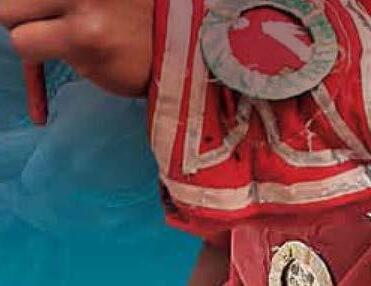
ancestral


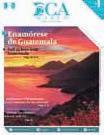
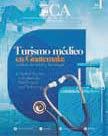
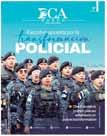
Contenido/ Content
Ciudades Solidarias que protegen a los migrantes
CiudadesSolidariasprotecting migrants
4 - 5 Un Gobierno que transforma a la niñez
A government that transforms children
6 - 7
8 - 9
10 - 11
12 -15
Un diálogo permanente con las comunidades originarias
A permanent dialogue with Indigenous peoples
Productos no tradicionales ascendieron en su exportación
Non-traditional products exports increased
Danza de las Guacamayas, historia de un rapto e Macaw Dance, an abduction story
Coloridos recorridos para conmemorar a quienes ya no están
Colorful tours to commemorate those who have passed away
16 -17
ChuweeD difunde su música a ritmo de cumbia y el clarinete
ChuweeD spreads his music to the rhythm of cumbia and clarinet
¡Recorra Guatemala en dos ruedas! Tour Guatemala on two wheels!
DCAMundonació con la finalidad de dar a conocer las acciones de gobierno en materia de economía, infraestructura, salud y educación; así como resaltar las relaciones diplomáticas y comerciales del Ejecutivo. A la vez, mostrar las bondades turísticas y culturales del país; y con ello, brindarle una mejor información sobre las acciones que se hacen y cambian a las comunidades para otorgarles un futuro prometedor.
Esta es nuestra última edición. Queremos agradecerle por acompañarnos durante casi cuatro años y darnos la oportunidad de mostrarle una mirada diferente a la Guatemala que acontece. En esta oportunidad, le comentamos
cómo ha avanzado el Organismo Ejecutivo para transformar la niñez con la ampliación de cobertura en la atención primaria en salud, así como los remozamientos a escuelas y crear actividades que fomentan el respeto hacia la niñez.
Asimismo, le compartimos el diálogo que se ha establecido con las comunidades originarias para avanzar en proyectos de infraestructura e identidad cultural.
Resaltamos la labor de las ciudades seguras en las comunidades y; por supuesto, le traemos los lugares para visitar en el Día de Todos los Santos. Guatemala saldrá adelante. ¡Hasta siempre!
DCA Mundo was born to have the government’s economic, infrastructure, health, and education actions known. It also highlights the government’s diplomatic and commercial relations, shows the country’s tourist and cultural benefits, and offers better information about the actions and changes in the communities to grant them a promising future.
is is our last edition. We want to extend our heartfelt thanks for your support over the past four years and are grateful for the opportunity to share our unique perspective on Guatemala with you. On this occasion, we
Dirección General: Carlos Morales Monzón
share the progress made by the Executive Branch in transforming childhood with the expansion of primary healthcare coverage, the refurbishment of schools, and the creation of activities that promote respect for children. We also share the dialogue established with the native communities to advance infrastructure and cultural identity projects.
We highlight the work of the Ciudades Solidarias, which has benefited hundreds of Guatemalans, and, of course, we bring you the places to visit during the All Saints’ Day celebrations. Guatemala will rise above. Farewell! 3
Coordinador de Redacción: Miguel González Moraga; Coordinación de Información: Mario Antonio Ramos; Editora: Katheryn Ibarra; Redactoras: María Godoy y Marisol Vásquez
Diseño: Sulhema Pacheco; Infografía: Sergio Espada y Erickson Hidalgo; Traducción: Nora Loesener; Digitalización: Freddy Pérez; Corrección: Pedro Meda y Servando Pineda
Chief Editor: Carlos Morales Monzón
Editorial Coordinator: Miguel González Moraga; Information Coordination: Mario Antonio Ramos; Editor: Katheryn Ibarra; Journalist: María Godoy and Marisol Vásquez; Graphic Design: Sulhema Pacheco; Infographics: Sergio Espada and Erickson Hidalgo; Translation: Nora Loesener; Digitization: Freddy Pérez; Style Editor: Pedro Meda and Servando Pineda
María Godoy
DCA Mundo
El municipio de Jutiapa ha sido el último en adherirse al Memorando de Intenciones de Ciudades Solidarias, una colaboración entre la Agencia de las Naciones Unidas para los Refugiados (Acnur), la Vicepresidencia de Guatemala, el Instituto Guatemalteco de Migración (IGM), la Secretaría contra la Violencia Sexual, Explotación y Trata de Personas (Svet) y otros actores clave.
Estas acciones demuestran un compromiso sólido con la creación de un entorno más inclusivo y humanitario para aquellas personas que han sido desplazadas y necesitan protección.
El principal objetivo de este programa es integrar y apoyar
María Godoy
DCA Mundo
The municipality of Jutiapa was the latest to join the Ciudades Solidarias Memorandum of Intent, a collaboration between the United Nations Refugee Agency (UNHCR), the VicePresidency of Guatemala, the Guatemalan Migration Institute (IGM), the Secretariat against Sexual Violence, Exploitation and Trafficking in Persons (SVET) and other key actors.
These actions demonstrate a solid commitment to creating a more inclusive and humane environment for those who have been displaced and need protection. e main objective of this program is to integrate and support people with refugee status in the country. Vice
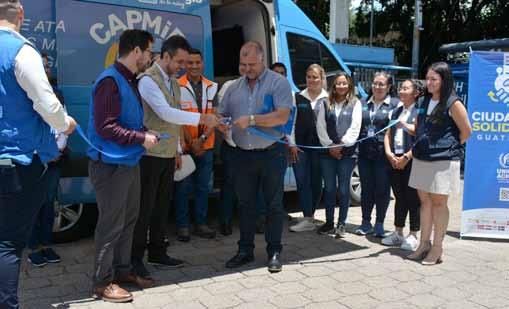
a las personas en condición de refugio en el país. La vicepresidenta Karin Herrera aseveró que se trabaja por una “sociedad justa e igualitaria”. Asimismo, se inauguró el Centro de Atención y Protección al Migrante y Refugiado Móvil (Capmir), diseñado para ofrecer un espacio seguro y donde las personas podrán recibir orientación legal, asistencia
President Karin Herrera stated they work for a “fair and equal society.”
e Mobile Assistance Center for Migrants and Refugees (Capmir) was inaugurated. It is designed to offer a safe space where people can receive legal orientation, psychosocial assistance, and access to basic The center will work with the Human Rights Ombudsman’s Office to guarantee comprehensive and timely protection..
psicosocial y acceso a servicios básicos, y trabajará de la mano con la Procuraduría de los Derechos Humanos para garantizar una protección integral y oportuna.
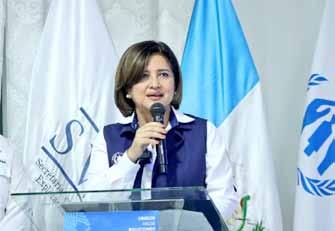

María
Godoy DCA Mundo
Generar condiciones de desarrollo para una vida plena en la primera infancia, niñez y adolescencia es uno de los objetivos de la Política de Gobierno 2024-2028. Se ha priorizado la atención en salud en primer y segundo niveles, así como la educación bilingüe e inclusiva, entre otras acciones.
En el mes de la niñez en Guatemala, compartimos los esfuerzos que se han hecho en el Organismo Legislativo. La primera dama de la nación, Lucrecia Peinado, participó en la IV Cumbre de Damas y Caballeros, en Kiev, Ucrania, donde se discutieron estrategias y políticas para la protección de la infancia. La delegación nacional reiteró continuar trabajando en favor del bienestar y desarrollo integral de los niños, sumándose a los esfuerzos internacionales para garantizar un futuro más justo y equitativo.
Anteriormente, el Ministerio de Relaciones Exteriores había reafirmado su compromiso en el Comité de Derechos del Niño de Naciones Unidas, donde se aseguraron las garantías básicas para el desarrollo.
En el ámbito nacional se ha ampliado la cobertura de cuidados. El proyecto Crecer Sano construye 37 puestos de salud, y de los cuales 13 ya están por inaugurarse; entre los últimos en iniciarse están el de Tacaná, San Marcos, y el de San Alfonso, Ixcán, Quiché.
“Estamos laborando para fortalecer el sistema de salud y poder trabajar en red, lo que significa que todos los servicios estén conectados”, comentó el viceministro de Atención
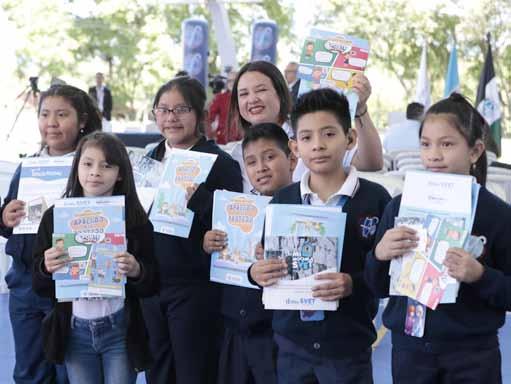
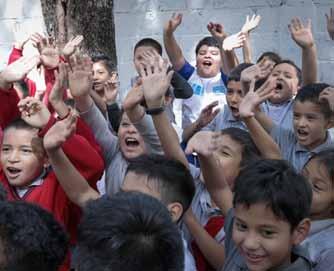
Primaria en Salud, Donato Camey.
Asimismo, se han intensificado los esfuerzos para la vacunación contra el sarampión, rubéola, paperas y poliomielitis, para impulsar personeros de salud se han disfrazado de superhéroes y así cumplir con el programa Vacunación en Acción. “Estamos protegiendo a la niñez de estas enfermedades”, afirmaron las
autoridades de la Dirección Departamental de Redes Integradas de Servicios de Salud (Ddriss) Guatemala, Área Nor occidente. En la misma línea, las brigadas de salud y nutrición han visitado casas para acercar los servicios y monitorear y prevenir la desnutrición.
“Aprovechamos estas visitas para asistir a mujeres en edad fértil y embarazadas, con lo cual buscamos reducir
riesgos de emergencias”, aseguró la cartera. En cuanto a la educación, se espera que al finalizar el año se hayan remozado 10 mil centros con el Programa de Mantenimiento de Edificios Escolares con una inversión de 750 millones de quetzales. Entre estos destacan Escuela Oficial Rural Mixta caserío Llano Largo, Jutiapa; Centro Oficial de Preprimaria Bilingüe (COPB); Escuela Oficial Rural Mixta (EORM) y el Instituto Nacional de Educación Básica de Telesecundaria (INEB).
A la vez, se han generado espacios amigables y de confianza con jóvenes y adolescentes, los cuales cuentan con el apoyo de la Secretaría contra la Violencia Sexual, Explotación y Trata de Personas (Svet). “Somos salud, somos prevención y tú eres parte vital para la construcción de sociedades seguras”, es el lema en estas charlas. Guatemala sigue saliendo adelante.
María Godoy DCA Mundo
Generating development conditions for a full life in early childhood, childhood, and adolescence is one of the Government policy 2024-2028 objectives. Priority has been given to first—and secondlevel health care, bilingual and inclusive education, and other actions.
In the month we celebrate Children’s Day in Guatemala, we share the efforts made in the Legislative Branch. e first lady of the nation, Lucrecia Peinado, participated in the IV Summit of Ladies and Gentlemen in Kyiv, Ukraine, where strategies and policies for the protection of children were discussed. The nation’s delegation reaffirmed its commitment to supporting children’s wellbeing and integral development, joining international efforts to guarantee a fairer and more equitable future.
Previously, the Ministry of Foreign Affairs had reaffirmed its commitment at the United Nations Committee on the Rights of the Child, where essential development safeguards were ensured.
Healthcare coverage has been expanded at the national level. The Crecer Sano (Grow Healthy) project is building 37 health posts, 13 of which will be inaugurated. One of the last openings was in Tacaná, San Marcos, and the other was in San Alfonso, Ixcán, Quiché. “We are working to strengthen the health system and to be able to work in a network, which means that all services are connected,” said the Vice Minister of Primary Health Care, Donato Camey.
Efforts have also been intensified to vaccinate against measles, rubella, mumps, and poliomyelitis to encourage health personnel to disguise themselves as superheroes to
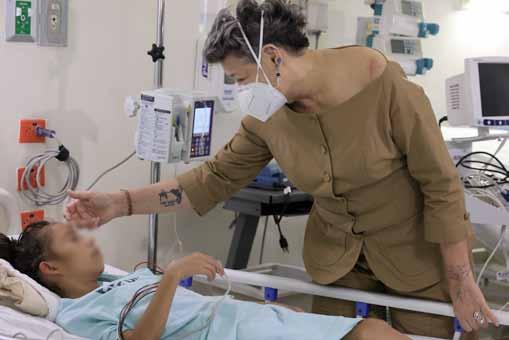
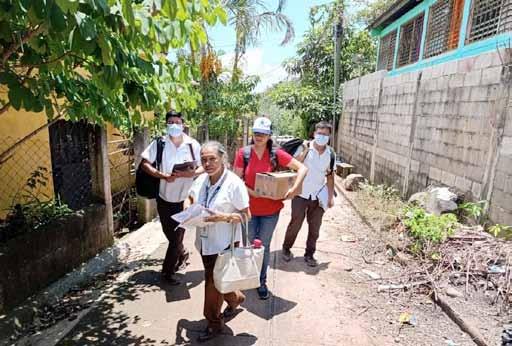
comply with the Vaccination in Action program. “We are protecting children from these diseases,” said the authorities of the Departmental Office of Integrated Health Services Networks -DDRISS- (acronym in Spanish) Guatemala, North West Area. Along the same lines, health and nutrition brigades have visited homes to bring services closer and to monitor and prevent malnutrition. “During these visits, we assist women of childbearing age and pregnant
women, and we seek to reduce the risk of emergencies,” said the Ministry.
As for education, it is expected that by the end of the year, 10 thousand centers will have been remodeled with the School Building Maintenance Program, with an investment of 750 million quetzals. Among the most important are the Escuela Oficial Rural Mixta Caserío Llano Largo Jutiapa, the Centro Oficial de Preprimaria Bilingüe (COPB); the Escuela Oficial
Rural Mixta (EORM) and the Instituto Nacional de Educación Básica de Telesecundaria (INEB). At the same time, friendly and trusting spaces have been created with young people and adolescents with the support of the Secretariat against Sexual Violence, Exploitation, and human traffick (SVET). “We are health, we are prevention, and you are a vital part of the construction of safe societies” is the motto taught in these talks. Guatemala will rise above.
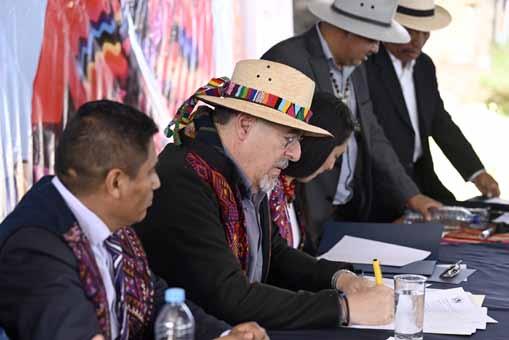
El presidente Bernardo Arévalo, del 14 de enero a la fecha ha firmado acuerdos con los pueblos ixil, xinka, chortí y tujaal, donde el Gobierno de Guatemala se ha comprometido a impulsar el desarrollo integral de las comunidades.
Entre los proyectos destaca la inversión en infraestructura en carreteras nacionales y municipales; la construcción de hospitales en Salquil Grande, así como la de plantas de tratamiento y la introducción de biofábricas para la producción de abonos. Asimismo, se establecieron medidas para la preservación de los idiomas, recuperación de temas ancestrales y la promoción de escuelas interculturales y bilingües. Todos estos proyectos están enfocados en mejorar la calidad de vida; también se ha girado instrucción para que el Ejecutivo implemente políticas por medio de los ministerios, viceministerios y secretarías. “Este es el primer Gobierno con el que estamos trabajando
mano a mano. Son puertas que estamos abriendo. Arévalo es el primer presidente que dialogó con su pueblo”, asegura Juan Carlos Toj, integrante de las comunidades aliadas de Chichicastenango.
Acceso a tierra
En las peticiones se prioriza la búsqueda de mecanismos para abordar los conflictos por el acceso a las tierras y que estas puedan ser producidas. Además, se ha creado un
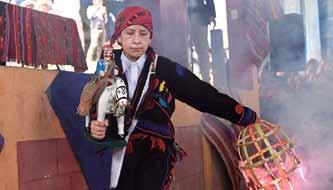
espacio político de comunicación permanente entre el Gobierno y las organizaciones campesinas, con la finalidad de anticipar y solventar conflictos. Esto ha hecho historia, puesto que es la primera vez en la que se ha logrado establecer un diálogo directo con las autoridades indígenas y ancestrales.
“Tengo la certeza de que escuchar esas voces antes silenciadas y poder reconocernos en el diálogo es clave para encontrar las soluciones a los problemas que seguimos arrastrando de nuestra historia, pero que tenemos que resolver si queremos un futuro de verdad diferente”, expresó el gobernante. “En esas voces está nuestro futuro”, puntualizó Arévalo.
Asimismo, durante este año se ha reunido con diferentes alcaldes y juridicciones ancestrales para llegar a acuerdos de lo que acontece en cada zona y velar para que se obtenga un mejor futuro. Estas acciones consolidan los mecanismos participativos en la formulación y ejecución de políticas públicas que impactan a las comunidades.
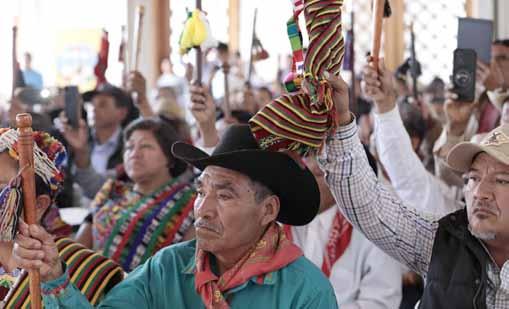
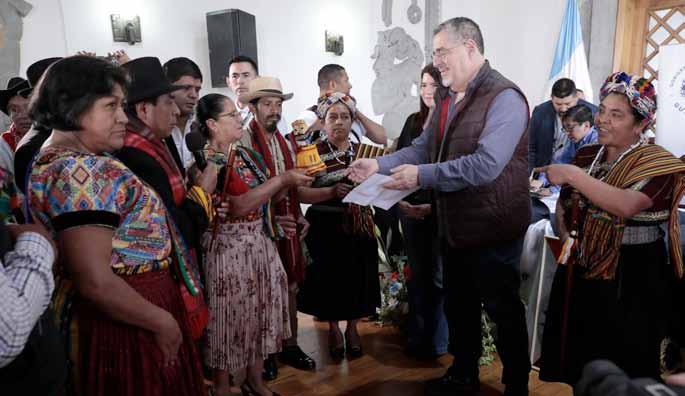
From January 14 to date, President Bernardo Arévalo has signed agreements with the Ixil, Xinca, Chortí, Tujaal, and Chichicastenango peoples, in which the Government of Guatemala has committed to promoting the comprehensive development of the communities.
The projects include infrastructure investment in national and municipal highways, the construction of hospitals in Salquil Grande, treatment plants, and the introduction of bio-factories for fertilizer production. In addition, measures were established for the preservation of languages, the recovery of ancestral themes, and the promotion of intercultural and bilingual schools.
Those projects focused on improving quality of life and instructed the Executive Branch to implement policies through the different ministries, viceministries, and delegations.
“ is is the first government with which we work hand in hand. ese are doors we are opening. Arévalo is the first president
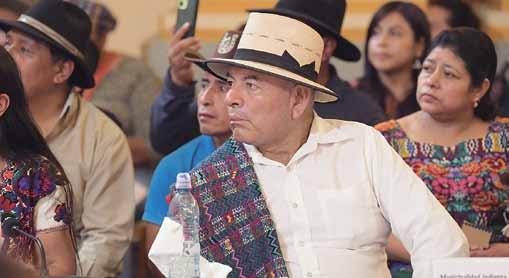
who dialogued with his people,” says Juan Carlos Toj, a member of the allied communities of Chichicastenango.
Among the requests is the search for mechanisms to address conflicts over access to land so that land can produce. A political space for permanent communication between the government and farmer organizations has also been created to anticipate and
resolve conflicts. is is history since it is first time that a direct dialogue has been established with indigenous and ancestral authorities.
“I am certain that listening to these previously silenced voices and being able to recognize each other in dialogue and conversation is key to finding solutions to the problems that we continue to drag from our history but that we have to solve if we want
a truly different future,” the President said. “Our future lies in those voices,” the President pointed out. Likewise, this year, he met with different mayors and ancestral authorities to agree on what was happening in each area and to ensure a better future.
These actions consolidate the participatory mechanisms in the formulation and execution of public policies that impact the communities.
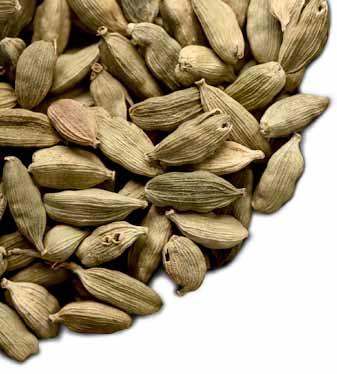
La Asociación de Exportadores de Guatemala (Agexport) afirmó que la exportación de productos no tradicionales ascendió a 4 mil 664 millones de dólares en el primer semestre de 2024. Entre ellos destaca, el cardamomo sin triturar, con un 49 por ciento en crecimiento, así como la energía eléctrica, en un 372 por ciento. Para la optimización de procesos se cuenta con nuevos portales, indicó la Agexport. El primero es el de Autogestión de la Ventanilla Única para las Exportaciones (VUPE), y el segundo de Autogestión, que dará mayor accesibilidad, ahorro de tiempo, transparencia y automía.
The most tradable in the year
Estos representan el 25 por ciento, según José Valladares, analista de Mercado Senior de Agexport These represent 25 percent, according to José Valladares, Senior Market Analyst at Agexport.
Artículos de vestuario
Grasas y aceites comestibles
and oils
Frutas frescas, secas o congeladas
dried or frozen
Materiales plásticos y sus manufacturas
Manufacturas de papel y cartón
Plastic materials and manufactures Paper and cardboard products
Accumulated goods as of July 2024
Proporción de comercio según sector

María Godoy/ DCA Mundo
The Guatemalan Exporters Association (Agexport) stated that exports of non-traditional products totaled 4,664 million dollars in the first semester of 2024. Uncrushed cardamom stands out, with a 49% growth, and electric energy, with a 372% growth. Agexport indicated that new portals have been created to optimize processes. The first is the Self-management of the Single Window for Exports (VUPE, acronym in Spanish), and the second is Self-management, which will provide greater accessibility, time savings, transparency, and automation.
mayor compra Regions with the most significant purchases
2 437
Norteamérica North America
*Cifras en millones de dólares
*Figures in millions of dollars
Europa Europe 493
2 383
América Central Central America
Portals
El de Autogestión de la Ventanilla Única para las Exportaciones (VUPE) y el de Autogestión de Agexport brindan diversidad de beneficios, entre los más destacados:
The Self-management of the Single Window for Exports (VUPE, acronym in Spanish) and Agexport's Self-management provide various benefits, among the most outstanding ones.
Accesibilidad: los exportadores pueden realizar sus gestiones desde cualquier dispositivo con acceso a internet.
Accessibility: exporters can carry out their formalities from any device with Internet access.
Transparencia: los usuarios pueden dar seguimiento en tiempo real a sus solicitudes, lo que aumenta la confianza y transparencia.
Transparency: users can track their requests in real-time, which increases trust and transparency.

Top countries
Estados Unidos
States
El Salvador Honduras

Costa Rica
Costa Rica
Países Bajos
Netherlands
Panamá
Panama
República Dominicana
Dominican Republic
Canadá
Canada
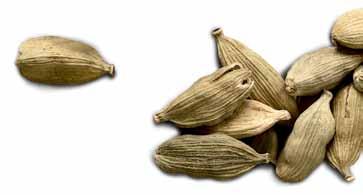
Growing
Ahorro de tiempo: el portal reduce, significativamente, los tiempos de espera para la tramitación de documentos y solicitudes.
Time savings: the portal significantly reduces waiting times for processing documents and applications.
Autonomía: el control total de la gestión está en manos del exportador, sin necesidad de intermediarios.
Autonomy: total management control is in the hands of the exporter, with no need for intermediaries.
Energía eléctrica Electricity
Cardamomo sin triturar ni pulverizar
T-shirts de algodón
Cotton T-shirts
Melones frescos
Fresh melons
Medicamentos (productos mezclados o sin mezclar preparados para usos terapéuticos)
Cardamom, neither crushed nor Medicines (mixed or unmixed products prepared for therapeutic uses)
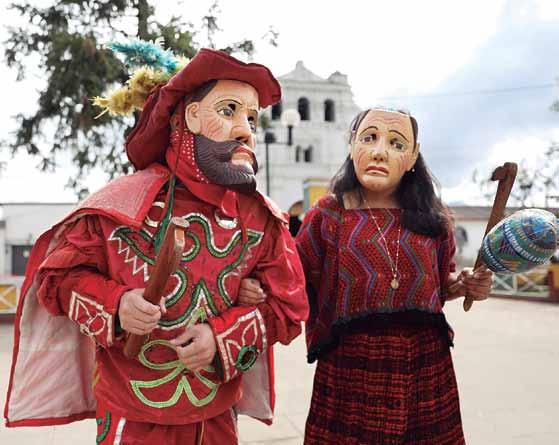
María Godoy DCA Mundo
Varios relatos mayas siguen vivos, tal es el caso de la Danza de las Guacamayas o de Ma’Muun que significa “La casa del gran señor”; esta nos lleva a Santa Cruz Verapaz, Alta Verapaz.
Historiadores la han comparado con el Rabinal Achí, pues ambas coreografías retratan el rapto de una doncella.
Guerreros con alas
La leyenda cuenta con diversas variantes en la región, según recoge el libro Tradición Popular, la danza del Ma’Muun de Carlos García Escobar, donde destaca que para algunos es un secuestro, mientras que para otros se trata de unos enamorados que huyen para poder vivir su amor.
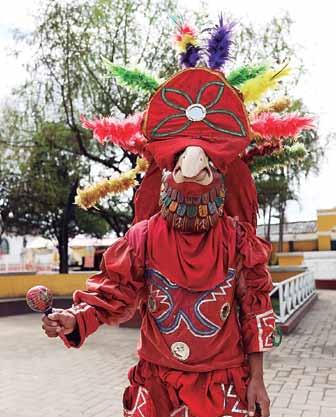
En la escena vemos a Quiché Winak, quien llega a la región para llevarse a una joven. Mientras se escucha la música que es interpretada por dos trompetas y un tun.
Los ancianos al darse cuenta de que su hija no se encuentra en casa, inician una búsqueda en las montañas y piden ayuda a los guerreros transformados en guacamayas.
Estas aves, que se distinguen por sus plumas rojizas, entran en combate con Quiché Winaq y se desata una lucha intensa, pero a Winaq le dan un golpe mortal. Ofrecen su sangre y su cuerpo a los espíritus de los cerros, mientras se escucha un graznido y comienza el viaje de vuelta a casa. García Escobar refiere que la sangre forma parte de un ritual del lugar. “Cuando se mata a un pavo, se da la sangre a los cuatro puntos cardinales, para proteger y agradecer a la tierra”.
Cabe resaltar que estas aves son nahuales de las mujeres y velan por ellas. Además, a las guacamayas también aparecen en los juegos de pelota y en artes mayas.
Los danzantes utilizan túnicas color escarlata para representar a las guacamayas, que además van adornadas con plumajes y se cubren la cara con una máscara en pico, para asemejarse al animal. En la espalda se observa un escudo con plumas.
Antes de realizar el baile, se hace un ritual donde se pide permiso a los dioses para poder representar la historia. La danza fue declarada Patrimonio Cultural Intangible de la Nación, según el Acuerdo Ministerial 442-2023. Guatemala, un lugar de creencias y de cultura viva.
María Godoy
DCA Mundo
Several Mayan stories are still alive, such as the Dance of the Macaw or Ma’Muun , which means “ e house of the great lord.” is takes us to Santa Cruz Verapaz, Alta Verapaz.
Historians have compared it to the Rabinal Achí since both choreographies portray the abduction of a maiden.
According to the book Tradición Popular, the Dance of the Ma’Muun by Carlos García Escobar, the legend has several regional variants. Some say it is a kidnapping, while others say it is about lovers who run away to live their love. In the scene, we see Quiché Winak arriving in the region to take a young woman while listening to the music played by two trumpets and a tun. The elders, realizing that their daughter is not at home, begin a search in the mountains and ask for help from the warriors transformed into macaws.
With their distinctive reddish feathers, these birds enter combat with Quiché Winaq, and an intense fight breaks out where both defend themselves. But, a Winaq gives a mortal blow, and they offer their blood and body to the spirits of the mountains while a squawk is heard, and the journey back home begins. García Escobar states that the blood is part of a ritual of the place: “When a chunte is killed, the blood is given to the four cardinal points, to protect and thank the earth.”
It is worth mentioning that these birds are nahuals of the women and watch over them (A nagual is an attendant animal spirit in many Mesoamerican belief systems). In addition, these feathered birds also appear in ball games and Mayan arts.
The dancers wear scarlet tunics adorned with feathers to represent macaws. They cover their faces with a beak mask to resemble the animal. On the back, a shield with feathers is worn.
Before dancing, a ritual takes place where permission is asked to the gods to represent the story. e dance was proclaimed an Intangible Cultural Heritage of the Nation, according to agreement ministerial 442-2023. Guatemala is a place of beliefs and living culture.
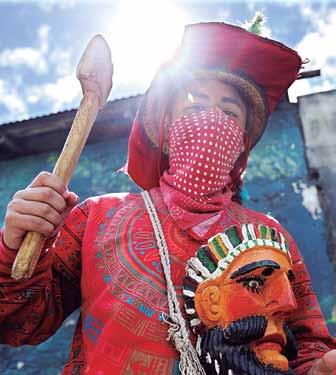
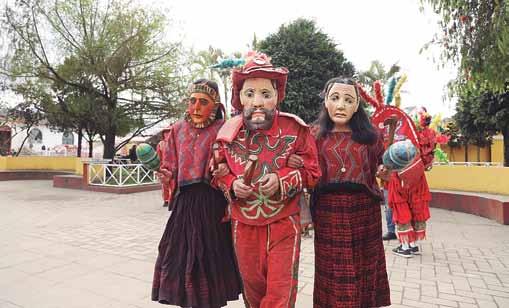
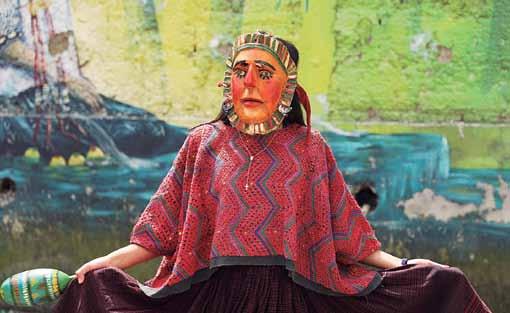
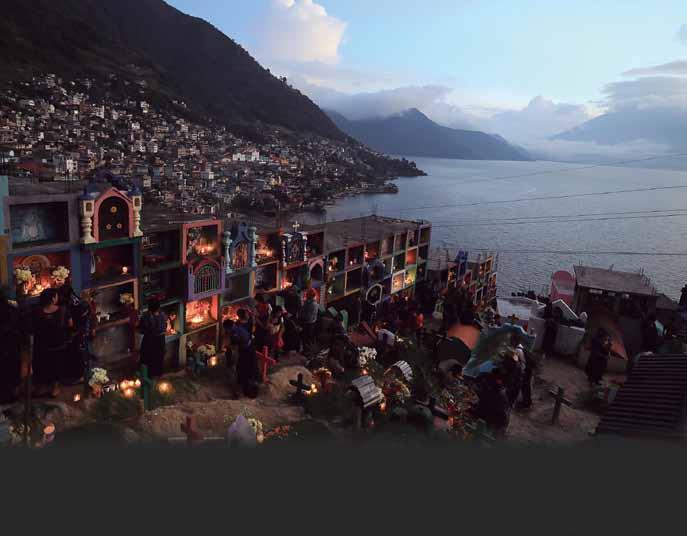
María Godoy DCA Mundo
Una festividad llena de color se celebra el 1 de noviembre en Guatemala: el Día de Todos los Santos. La comunidad
recuerda a quienes han partido con diferentes expresiones culturales que usted podrá disfrutar en octubre y noviembre. Los guatemaltecos durante el 1 de noviembre suelen visitar las tumbas,
llevar flores e incluso comer en el lugar el fiambre, una comida ofrenda que surge en el siglo XVI, que se relata en los escritos de José Milla en su libro Cuadro de Costumbres ( 1861 ) “Cuando (la gente) se cansó
de recorrer el panteón en todas direcciones y la Luna comenzaba a derramar su pálida luz sobre los mármoles de los sepulcros, fue alejándose poco a poco en busca del fiambre y de los otros platos que la costumbre quiere engullen los vivos al regresar de la visita a los restos inanimados de los muertos. Fiambre, en buen castellano, es un adjetivo que significa el asado o cocido que se ha dejado enfriar para comerlo así”.
Sin embargo, existen más actividades por conocer.
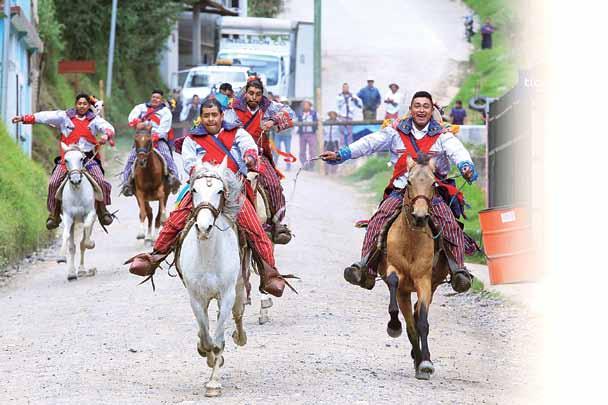
Carrera para las ánimas En Huehuetenango, se realiza la Carrera de las Ánimas o de las cintas, una tradición para muchos oscura, ya que se desafía a la muerte.
Su historia se remonta al tiempo de la colonización: cuando vecinos pidieron permiso a los españoles para utilizar los caballos; sin embargo, estos se negaron, afirmando que no eran capaces de montarlos, y estos se los llevan. Una noche antes de la galopada, se realiza un ritual y se pide permiso a la Madre Tierra, se sacrifican aves y los jinetes ingieren bebidas alcohólicas, pues deben montarlo en estado de ebriedad. Los animales son entregados a las 5:00 horas del 1 de noviembre y la carrera durará unas 10. Al no conocer al caballo hace que su travesía sea más desafiante.
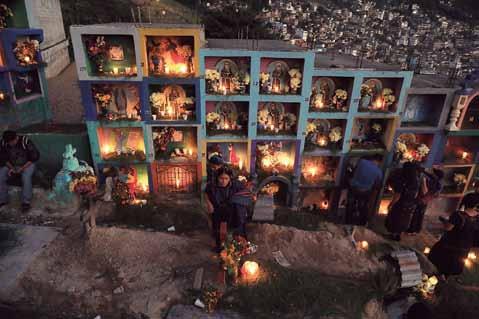
María Godoy DCA Mundo
Guatemala celebrates a colorful holiday on November 1, All Saints Day. The community remembers the departed with different cultural expressions, which you can enjoy in October and November.
During November 1st Guatemalans usually visit the tombs, bring flowers and even eat on site the famous fiambre, a food offering that began in the sixteenth century, which is narrated in the writings of José Milla in his book Cuadro de Costumbres ( 1861 ) “When (the people) were tired of touring the cemetery in all directions and the moon began to shed its pale light on the marble of the tombs, they gradually moved away in search of a better way of life, they went away little by little in search of the fiambre and the other dishes that the custom wants the living to gobble up when they return from the visit to the inanimate remains of the dead. Fiambre, in good Spanish, is an adjective that means the roast or stew left to cool to eat it cold.”
However, there are more activities to know.
A race for the souls In Huehuetenango, the Race of the Souls or the ribbons occurs, a dark tradition for many since death is challenged.
Its history goes back to colonization; a group of neighbors asked permission from the Spaniards to use horses; however, they refused, stating that they could not ride them. One night before the gallop, a ritual takes place where permission is asked to Mother Earth, several birds are sacrificed, and the riders drink alcoholic beverages since they must ride the horse drunk. e horses are delivered at 5 o’clock on November 1, and the race will last about 10 hours. Not knowing the horse makes the journey more dangerous and challenging.Another atrraction is the giant kites
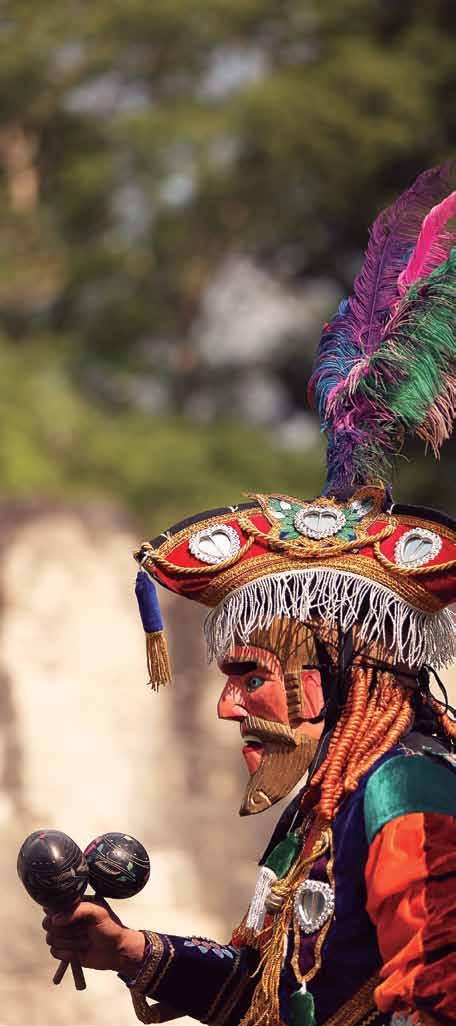
Barriletes gigantes
Otro de los atractivos son los barriletes gigantes de Santiago y Sumpango Sacatepéquez, que miden cerca de 16 metros y son elevados durante el 1 de noviembre, pero además hay una exposición durante todo el mes. La técnica de elaboración busca ser adherida en la lista representativa del Patrimonio Cultural Inmaterial de la Humanidad, de la Organización de las Naciones Unidas para la Educación, la Ciencia y la Cultura (Unesco), y será discutida en diciembre de este año.
Según cuentan los habitantes, la elaboración de estos barriletes se inició, ya que los espíritus malignos rondaban el cementerio para molestar a las almas, por lo que los ancianos decidieron “volar papeles” para que su sonido los ahuyentará. Mientras que otra leyenda, describe que los barriletes son una forma de comunicarse con aquellos que ya han partido y que en su cola se suelen escribir mensajes que son leídos por las almas.
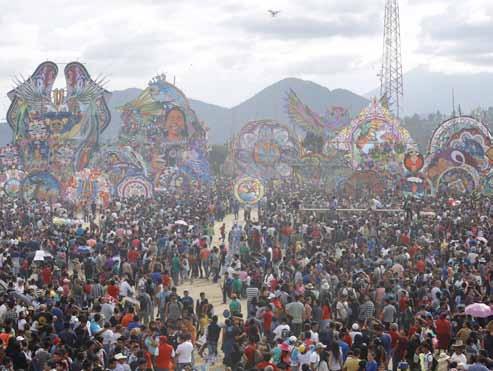
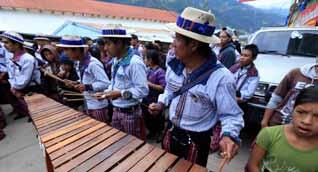
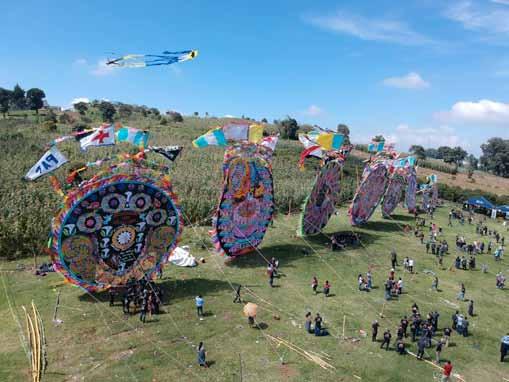

Entre bailes y teatro
Se celebran del 21 de octubre al 2 de noviembre en conmemoración de To dos Los Santos, se encuentra Los Ixcampores El Venado y ElTorito, las cuales conmemoran la trascendencia y se dan sobre todo en Huehuetenango.
M ientras, en la ciudad de Guatemala podrá apreciar la obra de Don Juan Tenorio, donde los protagonistas se enfrentan a sus fantasmas y a la hora de su muerte piden perdón a Dios. Disfrute de las tradiciones de nuestro país.
of Santiago and Sumpango Sacatepéquez, which measure about 16 meters and are raised on November 1. There is also an exhibition thorughout the month.
e elaboration tecnique aims to be added to the representative llist of the Intangible Cultural Heritage of Humanity of the United Nations Educational, Scnientific and Cultural Organization (Unesco). It will be discussed in December of this year.
According to the locals, the elaboration of these kites began because evil spirits haunted the cemetery to bother the souls. So, the elders decided to “flypapers” so that their sound would scare them away. Another legend describes that the kites are a way to communicate with those who have already departed and that messages are usually written on their tails that the souls read.
Between dances and theater
Among the dances celebrated from October 21 to November 2 in commoration of All Saints are Los Ixcampores, El Venado, and El Torito, which commemorate transcendence and occur mainly in Huehuetenango.
Meanwhile, in Guatemala City you can appreciate the work of Don Juan Tenorio, where the protagonists face their ghosts and at the time of their death ask God for forgiveness. Enjoy the traditions of our country.
FOTO/PHOTO: DANILO RAMÍREZ
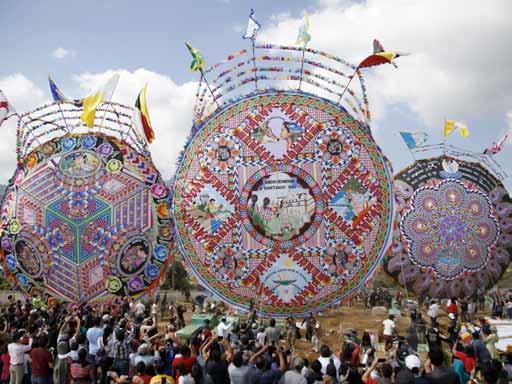
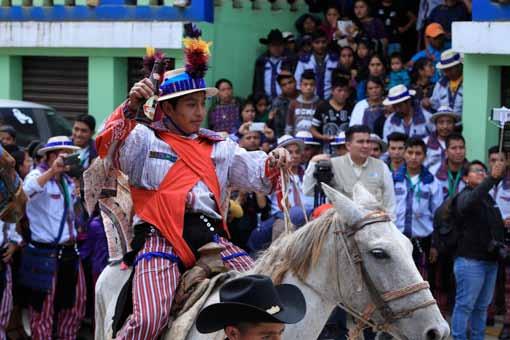
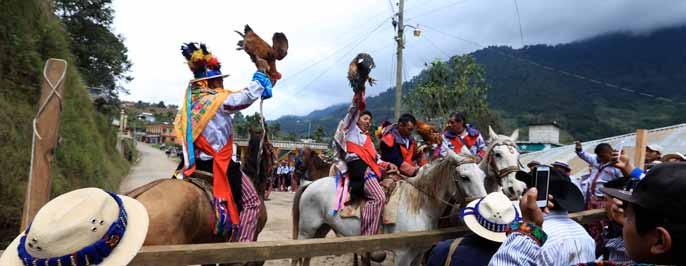

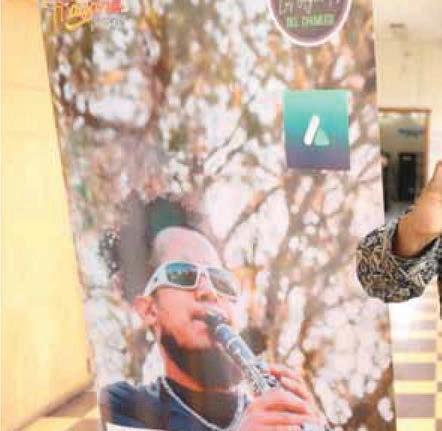
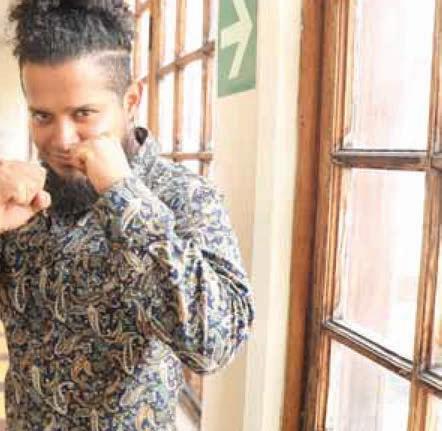


Narcy Vásquez
DCA Mundo
Douglass Melquisedec Sagastume Ajché, conocido artísticamente como ChuweeDClarinete loco, se ha desarrollado en el ambiente musical desde hace unos 15 años con varias agrupaciones, aunque en el presente es solista. Está promocionando su sencillo El Flow de Lester Martínez, un destacado boxeador guatemalteco, quien ya lo escuchó y agradeció la composición.
Se crió en la colonia capitalina
La Verbena, donde una visita cambió su vida en 180 grados, cuando llegaría un proyecto organizado por los maestros
María Isabel Ciudad Real, decana de la Facultad de Música de la Universidad del Valle de Guatemala, e Igor Sarmientos
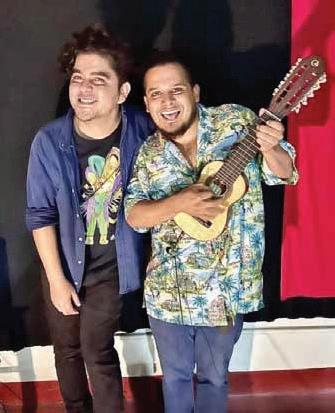

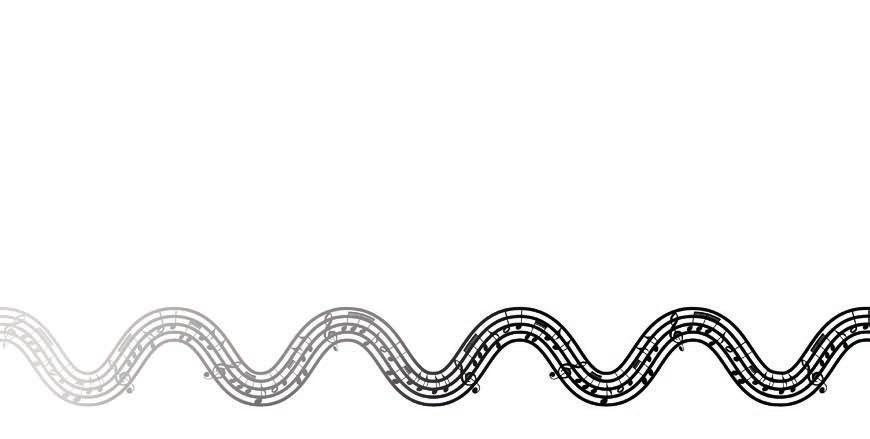
hijo, que lo apoyaron para arrancar su profesión. “Un día abordé una camioneta camino a la avenida La Reforma y un don tocó la flauta; en ese tiempo, analizaba cómo generar dinero; entonces, observé que en cuestión de tres minutos había reunido una buena cantidad, entonces seguí su ejemplo”, refiere.
Llevando música
Estudió en el Conservatorio Nacional de Música German Alcántara, la Escuela Militar de Música Maestro Rafael Álvarez Ovalle y la Escuela para Maestros de Educación Musical Alfredo Colom. Ha interpretado sus conocimientos tanto en los escenarios como en algunos buses, donde tiempo atrás conoció al rapero Big James, con quien comenzó su carrera artística popular con la agrupación Tiempo Azul. Ahora da a conocer su álbum producido por varios artistas en colaboraciones con expositores del género en el país, con la banda de cumbia los Aguacates del ChuweeD. “Por el momento somos dos, pero ya me visualizo con 15 personas en el escenario, marimba en vivo, saxofones porque tenemos la capacidad y educación para dirigirlo”, expresó el músico.
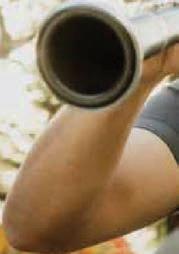
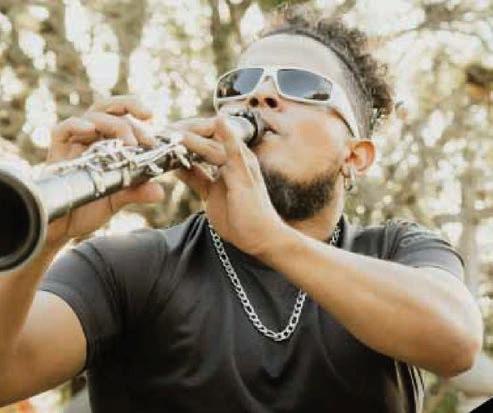


Narcy Vásquez
DCA Mundo
Douglass Melquisedec Sagastume Ajché, artistically known as ChuweeD-Clarinete loco, has performed in the music scene for about 15 years with several groups and is currently a soloist. He is promoting his single Lester Martínez’s El Flow, a prominent Guatemalan boxer who has already listened to and appreciated the composition.
He grew up in the La Verbena neighborhood, where a visit changed his life 180 degrees when a project organized by the teachers María Isabel Ciudad Real, dean of the Faculty of Music at the Universidad del Valle de Guatemala and Igor Sarmiento’s son, who gave him support to start his profession.
“One day, I went by bus to La Reforma Avenue, and a guy
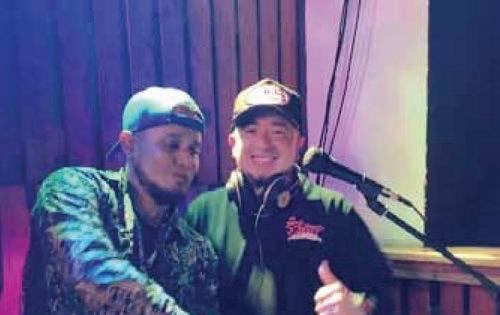

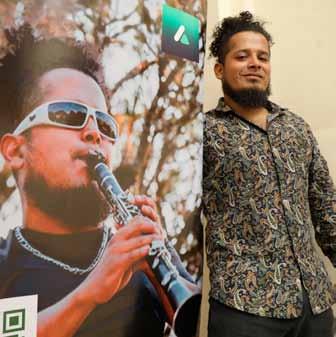
played the flute; at that time, I was analyzing how to generate money, then I noticed that in a matter of three minutes, he had made a good amount of money,
so I followed his example,” he said.
He studied at the Conservatorio
Nacional de Música German Alcántara, the Escuela Militar de Música Maestro Rafael ÁlvarezOvalle , and the Escuela para Maestros de Educación Musical Alfredo Colom. He has performed both on stage and on some buses. He met rapper Big James some time ago, with whom he began his popular artistic career with the group Tiempo Azul.
Now, he promotes his album, produced by several artists in collaboration with exhibitors of the genre in the country, with the cumbia band Los Aguacates del ChuweeD.
“At the moment, there are two of us, but I already visualize myself with 15 people on stage, live marimba, and saxophones because we have the capacity and the academic preparation to lead it,” expressed the musician.
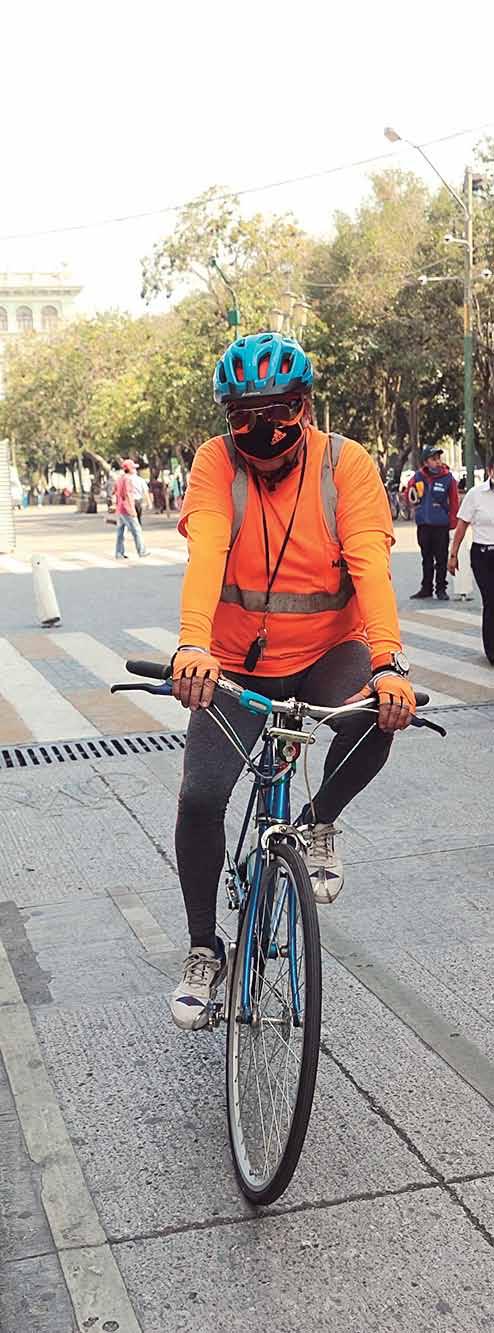
María Godoy DCA Mundo
Déjese sorprender por las maravillas que ofrece Guatemala y atrévase a recorrer los espacios con naturaleza, parques y las diferentes vías en bicicleta. ¿Está listo para la aventura?
La Antigua Guatemala Sacatepéquez
Usted podrá recorrer 18 kilómetros entre La Antigua Guatemala, Jocotenango y Ciudad Vieja, Sacatepéquez. Este es uno de los lugares en donde además se practica turismo comunitario.
Atitlán, Sololá
Sololá cuenta rutas para practicar bicicleta de montañismo, una de ellas es de Panajachel al mirador que se encuentra en Santa Catalina, donde observará el lago Atitlán y el volcán San Pedro. Otra de las vías es el Cerro de Oro, en Atitlán, que se cree que inspiró a Saint-Exupéry a escribir ElPrincipito
Áreas protegidas
Otras de las opciones que ofrece Guatemala son varias áreas protegidas donde podrá compartir con la naturaleza, como el Parque Naciones Unidas, en el departamento de Guatemala; la Reserva
Natural de los Terrales, en Suchitepéquez.
Ciudad de Guatemala
La ciudad de Guatemala cuenta con ciclovías en la avenida de las Américas; Cantón, zona 4; El Mapa de Relieve, avenida Petapa, de la 29 hasta la 51 calles, y por supuesto, la Reforma, donde podrá contemplar monumentos como a Juan Pablo Segundo, a La Madre o bien el del escritor Miguel Ángel Asturias.
El Centro Deportivo Erick Bernabé Barrondo García es un pulmón verde en el corazón de la ciudad de Guatemala; con una extensión de 95 manzanas. También hay lugares diseñados para que usted pueda practicar ciclismo de montaña, como por ejemplo San Agustín Bike Park, El Socorro, entre otros.
Además, si usted practica este deporte, podrá observar la Vuelta Ciclística a Guatemala, la cual se celebra cada año.
En su 63 edición, será del 25 de octubre al domingo 3 de noviembre de 2024. Se trata de una desfío por etapas que recorre las carreteras de Guatemala. Esta carrera es catalogada como de categoría 2.2 y forma parte del UCI America Tour.
FOTOS/PHOTOS:DANILO RAMÍREZ
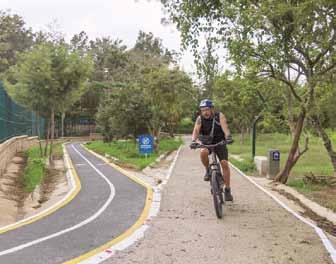
María Godoy
DCA Mundo
Let yourself be surprised by Guatemala’s wonders and dare to explore the natural spaces, parks, and bicycle routes. Are you ready for the adventure?
Antigua Guatemala Sacatepéquez
You can travel 18 kilometers between Antigua, Guatemala, Jocotenango, and Ciudad Vieja in Sacatepéquez. is is one of the places where community tourism is also practiced.
Atitlán, Sololá
Sololá offers different mountain biking paths. One is from Panajachel to the Mirador in Santa Catalina, where you can see Lake Atitlán and the San Pedro volcano. Another route is the Cerro de Oro in Atitlán, believed to have inspired SaintExupéry to write The Little Prince.
Protected areas
Guatemala also offers several protected areas to connect with nature, such as the United Nations Park in the Department of Guatemala and the Natural
Reserve of the Terrales in Suchitepéquez.
Guatemala City
Guatemala City has bike paths on Las Americas Avenue, Canton, zone 4, El Mapa del Relieve, Petapa Avenue from 29th Street to 51st Street, and, of course, La Reforma, where you can contemplate monuments such as Pope John Paul II, the monument to La Madre, or the memorial of the writer Miguel Angel Asturias.
Erick Barrondo Park
The Erick Bernabé Barrondo García Sports Center is a green lung in the heart of Guatemala City, with an extension of 95 blocks. There are also places designed for you to practice mountain biking, such as San Agustín Bike Park, El Socorro, and others.
Also, if you practice this sport, you can compete in the Vuelta Ciclística a Guatemala, which is held annually. Its 63rd edition will be held from October 25 to Sunday, November 3, 2024. It is a stage competition that travels the roads of Guatemala. This
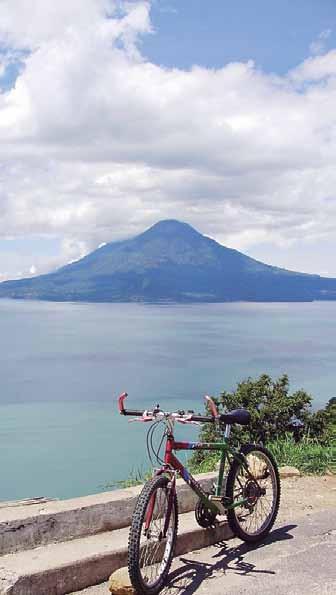
race is classified as category 2.2 and is part of the UCI America Tour. doluptio tem simusan
ditatquam idelestrum quias rempore evellab oreistemruntia solorib ustius ipientist que
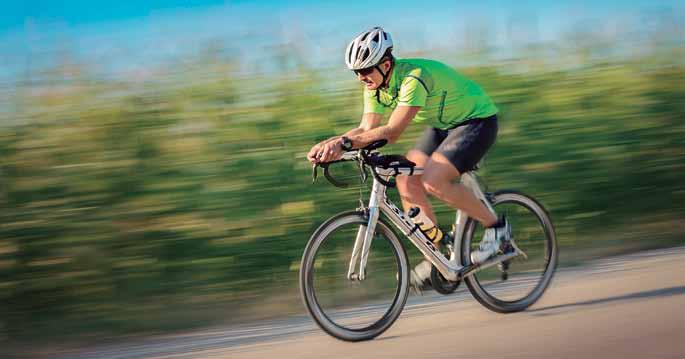

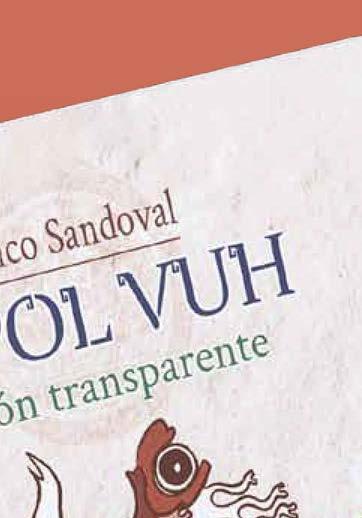

PRECIO / PRICE:
Colecciones recientes de historia, poesía y narrativa. Recent history, narrative, and poetry collections.

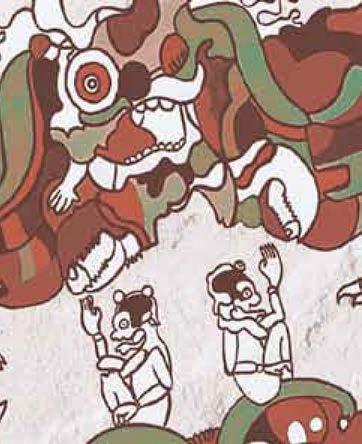

Un recorrido de un pueblo, desde la creación del mundo hasta la llegada de los españoles a tierras guatemaltecas.

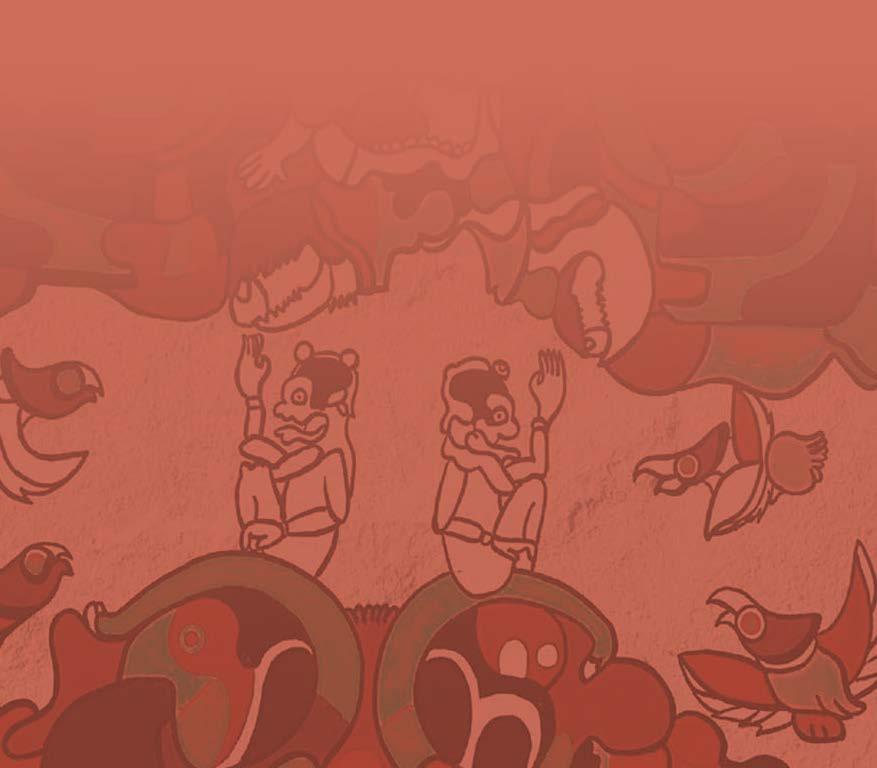
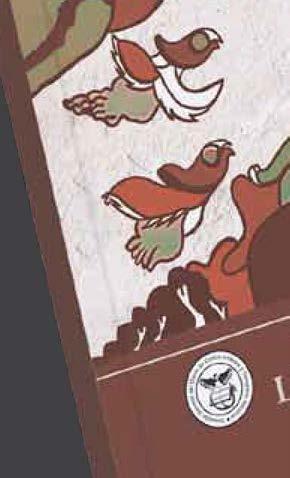



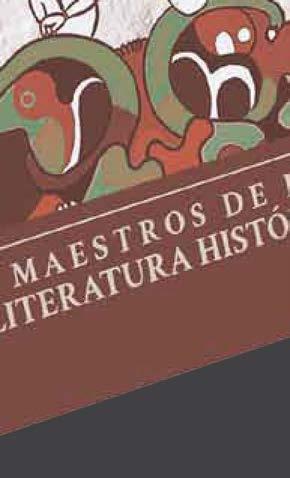

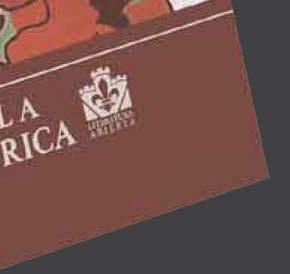

A journey of a people, from the creation of the world to the arrival of the Spanish to Guatemalan lands.

Solicítelas al / For purchasing contact: Ext. 112 1590
o visítenos en nuestra sala de ventas en Tipografía Nacional / Come and visit us at our sales room in Tipografía Nacional.